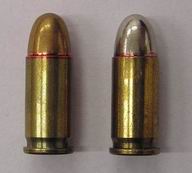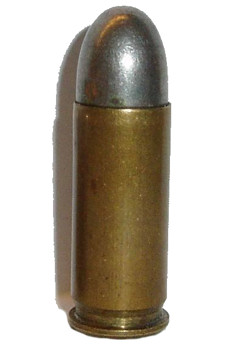
The .45 ACP, also known as .45 Auto, .45 Automatic, or 11.43×23mm is a rimless straight-walled handgun cartridge designed by John Moses Browning in 1904, for use in his prototype Colt semi-automatic pistol. After successful military trials, it was adopted as the standard chambering for Colt's M1911 pistol. The round was developed due to a lack of stopping power experienced in the Moro Rebellion in places like Sulu. The issued ammunition, .38 Long Colt, had proved inadequate, motivating the search for a better cartridge. This experience and the Thompson–LaGarde Tests of 1904 led the Army and the Cavalry to decide that a minimum of .45 caliber was required in a new handgun cartridge.

.32 ACP is a centerfire pistol cartridge. It is a semi-rimmed, straight-walled cartridge developed by firearms designer John Browning, initially for use in the FN M1900 semi-automatic pistol. It was introduced in 1899 by Fabrique Nationale, and is also known as the 7.65×17mmSR Browning or 7.65 mm Browning Short.

The .38 Super, also known as .38 Super +P, .38 Super Auto, .38 Super Automatic, .38 Super Automatic +P, or 9×23mmSR, is a pistol cartridge that fires a 0.356-inch-diameter (9.04 mm) bullet. It was introduced in the late 1920s as a higher pressure loading of the .38 ACP, also known as .38 Auto. The older .38 ACP cartridge propels a 130-grain (8.4 g) bullet at 1,050 ft/s (320.0 m/s), whereas the .38 Super pushes the same bullet at 1,280 ft/s (390.1 m/s). The .38 Super has gained distinction as the caliber of choice for many top practical shooting competitors; it remains one of the dominant calibers in IPSC competition.
A rim is an external flange that is machined, cast, molded, stamped, or pressed around the bottom of a firearms cartridge. Thus, rimmed cartridges are sometimes called "flanged" cartridges. Almost all cartridges feature an extractor or headspacing rim, in spite of the fact that some cartridges are known as "rimless cartridges". The rim may serve a number of purposes, including providing a lip for the extractor to engage, and sometimes serving to headspace the cartridge.

L. W. Seecamp Co. was an American manufacturer of pocket pistols located in Milford, Connecticut from 1981 to 2014. In 2014, Whalley Precision purchased the company and took over production of the pistols from their facility in Southwick, Massachusetts.

The .44 Auto Mag pistol (AMP) is a large caliber semi-automatic pistol. It was designed between 1966 and 1971 by the Auto Mag Corporation to make a semi-automatic pistol chambered in .44 AMP.

A moon clip is a ring-shaped or star-shaped piece of metal designed to hold multiple cartridges together as a unit, for simultaneous insertion and extraction from a revolver cylinder. Moon clips may either hold an entire cylinder's worth of cartridges together, half a cylinder, or just two neighboring cartridges. The two-cartridge moon clips can be used for those revolvers that have an odd number of loading chambers such as five or seven and also for those revolvers that allow a shooter to mix both rimless and rimmed types of cartridges in one loading of the same cylinder.

The AMT Hardballer is a series of pistols that are part of the 1911 platform made by Arcadia Machine & Tool (AMT) from 1977 to 2002. The Hardballer was the first entirely stainless steel 1911 pattern pistol. Other features included adjustable rear sights and a lengthened grip safety.

In American English, a pocket pistol is any small, pocket-sized semi-automatic pistol, and is suitable for concealed carry in a pocket or similar space.

The .38 ACP, also known as the .38 Auto or 9x23mmSR, is a semi-rimmed pistol cartridge that was introduced at the turn of the 20th century for the John Browning-designed Colt M1900. It was first used in Colt's Model 1897 prototype, which he did not produce. The metric designation for the round is 9×23mm SR (semi-rimmed), which is not to be confused with other 9×23mm cartridges.

The .400 Corbon is an automatic pistol cartridge developed by Cor-Bon in 1997. It was created to mimic the ballistics of the 10 mm Auto cartridge in a .45 ACP form factor. It is essentially a .45 ACP case, necked down to .40 caliber with a 25-degree shoulder.

The Colt Commander is a single-action, semi-automatic, magazine-fed, and recoil-operated handgun based on the John M. Browning–designed M1911. It was the first mass-produced American pistol with an aluminium alloy frame and the first Colt pistol to be chambered in 9mm Parabellum.

A snubnosed revolver is a small, medium, or large frame revolver with a short barrel, generally less than 4 inches in length. Smaller such revolvers are often made with "bobbed" or "shrouded" hammers and there are also "hammerless" models ; the point is to allow the gun to be drawn with little risk of it snagging on clothing. Since the external movement of the mechanism is minimal or nil, shrouded and hammerless models may be fired from within clothing. The design of these revolvers compromises range and accuracy at a distance in favor of maneuverability and ease of carry and concealment.

The Colt Double Eagle is a double-action / single action, semi-automatic pistol manufactured by Colt's Manufacturing Company between 1989 and 1997. It was available in standard full-size, as well as in more compact versions. It featured a decocking lever, and was chambered for several calibers. The family of models was known as the Series 90.

A handgun is a firearm designed to be usable with only one hand. It is distinguished from a long gun which needs to be held by both hands and braced against the shoulder. The two most common types of handguns are revolvers and semi-automatic pistols, although other types such as derringers and machine pistols also see infrequent usage.

SIG Sauer of Newington, NH United States manufactures a full line of 1911 styled handguns. The earliest models were very faithful to the John M. Browning designed Colt M1911 Pistol which became the United States standard sidearm and served in that capacity for some seven decades before being replaced by the Beretta M9 handgun.
The Colt Model 1903 Pocket Hammer was a short-recoil, semi-automatic pistol, designed by the American arms designer John Browning. It was a compact version of the Colt Model 1902 Sporting Model pistol derived from the original Colt M1900. The Colt M1902 Sporting Model and 1903 Pocket Hammer models differ significantly from the military-inspired Colt 1902 Military Model although they fire the same cartridge. Its design is in no way related to the Colt Model 1903 Pocket Hammerless or the FN Model 1903 pistol.

The 9×23mm Winchester is a pistol cartridge developed as a joint venture by Winchester Ammunition and Colt's Manufacturing Company. The 9×23mm Winchester has a convoluted development history, but was commercially introduced by Winchester in 1996. Marketed primarily to competition shooters as a replacement for .38 Super for International Practical Shooting Confederation, United States Practical Shooting Association and International Defensive Pistol Association competition, the cartridge failed to find significant market success despite a high-profile introduction.
The .40 Super is a powerful automatic pistol cartridge developed in 1996 and introduced to the market by Triton Cartridge. The cartridge was co-developed by Fernando Coelho and Tom Burczynski.
















